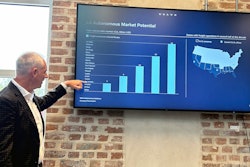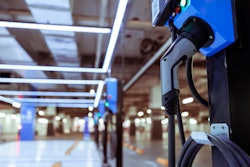Smartphones, with the exception of the iPhone with its unique brand equity, have become largely commoditized.
Webster defines a commodity as “a good or service that is widely available, interchangeable and undifferentiated in terms of attributes or quality.”
Brand loyalty aside, most of the features of various smartphones have become ubiquitous so there is not as much competition on capability. People just want a phone now and expect nearly all the bells and whistles to be there.
The deal with becoming a commodity is that competition migrates from “the next cool feature” to focusing on price and availability. An example in trucking is where a shipper is just looking to move product from point A to B and needs “a truck and a driver” as opposed to needing a model year 2023 Freightliner with a Schneider driver, for example. Trucks becoming commodities is how third-party logistics (3PLs) and fourth-party logistic (4PLs) have made such headway in the industry.
I had never heard of 3PLs and 4PLs until a couple years ago. Even though they had been around for a while, they were not making headlines. 3PLs outsource much of the logistics of moving, warehousing and distributing products for shippers. They are particularly valuable to start-up manufacturers that want to get their product out but don’t want to become experts in shipping and warehousing. 3PLs are thriving in ecommerce.
4PLs are companies providing an entire supply-chain management system for a product producer. The difference between 3PLs and 4PLs appears to primarily be one of scale.
The point is that not everyone wants to be intimately engaged in buying and operating trucks, buying and operating warehouses, or moving product. Some companies just want to outsource all that “transportation overhead” so they can focus on their core centers of excellence: producing and marketing products.
What is interesting today is that these companies that have put transportation at arm's length from their mahogany row management offices are being forced into caring about the specifics of the trucks because of the need to have sustainability plans, the need to care about environmental justice, and the need know the how, where and what of their shipping operations. While they may want the simplicity of just paying another company to care about the shipping details, they can’t distance themselves from the reality that everything they do has ramifications to the environment and communities through which their products move.
At the same time, the 3PLs and 4PLs are having to pay much more attention to the details of their shipping systems and report those to their customers. As we found in interviewing fleets, 3PLs and 4PLs for Run on Less – Electric DEPOT, many shippers now are differentiating services on the basis of whether the transportation is environmentally and socially responsible. Fleets have to provide quantifiable metrics so the shippers can satisfy their sustainability reporting needs.
Today’s shippers can’t escape needing to know whether trucks are zero emission, near zero emission or legacy trucks of various vintages. They will need to know whether the refrigerated trailers they are using are similarly zero emission. They will need to know the energy rubric of the warehouses their products are moving through.
The digitization of supply chain information from the order placement to delivery is providing massive amounts of data. The term “big data” seems to grossly underestimate this. Perhaps gargantuan better describes the sheer volume of information readily available. Today we can track our shipment from the moment we order it to the second it arrives. Shippers and fleets know which trucks, which drivers, which trailers, which warehouses and which routes are in use to move products. The supply chain is no longer a mystery lost in paper forms spread across multiple isolated filing cabinets.
Fleets know how much energy they are paying for transporting the vehicles. Accountants know how much fuel is purchased per truck, which state it was purchased in and in which states the fuel was expended. Zero-emission vehicles, while slightly different fuel pumps, are not a free ride and the accountants know what it costs to power each truck.
The challenge for the trucking industry is seamlessly tying all that data into readily useable dashboards tuned to each user’s needs. The software companies have been salivating over these opportunities for years.
The fundamental challenge with software and data is change. Software companies are constantly changing software. The computers they run on are also constantly changing. The data collection systems that run on both the computers and the software are constantly changing. It is not uncommon that all of these changes are not backwards compatible. How will fleets, shippers, 3PLs and 4PLs navigate software and hardware obsolescence moving forward?
I am in awe that our Air Force flies the venerable B-52, including some that are more than 70 years old. The planes have been in active service so long that some of them have been flown by the children of earlier B-52 pilots. The Chinook helicopter and the A-10 ground attack aircraft have had lengthy lives, and somehow the software, hardware and data has kept them in the air.
Now look at PCs. How many laptops have crossed under your fingers in the last 25 years? How many were obsoleted by the latest new processor, new software, or new database management system? Those in the computer aided design (CAD) world are very familiar with having to make major investments in time, labor and dollars to update aging CAD data for the next great product lifecycle management (PLM) database. Finance, purchasing and accounting groups are probably very familiar with the fragility and limitations imposed by aging information systems — some based on software systems like COBOL that are no longer taught in schools.
The commoditization of trucking and transportation is opening challenges for hardware that has the potential of lasting decades. Trucks, warehouses, fueling systems and charging systems all have the potential of capital investment lifespans longer than the next software or hardware upgrade.
It is very challenging to envision the digital infrastructure that will be keeping vehicles productive as their age and miles accumulate. We regularly celebrate today’s million-mile drivers. We need to start including million-mile trucks and 10- or 20-year warehouses, or 10- or 20-year fueling and charging infrastructure. The commoditization of transportation brings challenges that spread across shippers and fleets, irrespective of whether 3PLs and 4PLs are engaged.












